|
|
|
Sort Order |
|
|
|
Items / Page
|
|
|
|
|
|
|
| Srl | Item |
| 1 |
ID:
069880


|
|
|
|
|
| Publication |
2005.
|
| Summary/Abstract |
Coercive diplomacy has long been seen as a viable alternative to war by political decision-makers. There is, however, a long line of credible academic and policy critique-stretching back to the Cold War-that asserts the failures of coercion almost always overwhelm its benefits. Our examination of the 2001-2002 Indo-Pakistani crisis supports the overall analytical consensus that coercive methods, under certain circumstances, accomplish little. We discover that India's use of coercive diplomacy was severely hobbled because of Pakistan's possession of nuclear weapons, strong Pakistani conventional forces, and other geopolitical realities that strongly favored Pakistan. Despite careful attempts by Indian elites to apply the principles of "forceful persuasion" to end the crisis on terms favorable to India (the stronger power in the dispute), the Indian strategy failed to accomplish most of its objectives. Our analysis thereby exposes the limits of coercion and compellance for solving chronic territorial and ideological disputes between enduring rivals
|
|
|
|
|
|
|
|
|
|
|
|
|
|
|
|
| 2 |
ID:
162482
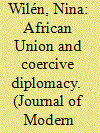

|
|
|
|
|
| Summary/Abstract |
In December 2015, the African Union (AU) took the unprecedented step of threatening to use military force against the government of Burundi's wishes in order to protect civilians caught up in the country's intensifying domestic crisis. This article traces the background to this decision and analyses the effectiveness and credibility of the AU's use of coercive diplomacy as a tool of conflict management. After its usual range of conflict management tools failed to stem the Burundian crisis, the AU Commission and Peace and Security Council tried a new type of military compellence by invoking Article 4(h) of the Union's Constitutive Act. We argue that the threatened intervention never materialised because of (1) the Burundian government's astute diplomacy and (2) several African autocrats’ resistance to setting a precedent for future interventions where concerns about civilian protection might override state sovereignty.
|
|
|
|
|
|
|
|
|
|
|
|
|
|
|
|
| 3 |
ID:
151281
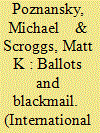

|
|
|
|
|
| Summary/Abstract |
Does the restraint that prevents pairs of democracies from fighting large-scale wars also prevent them from coercing one another? While scholars have long drawn a bright line between using force and threatening it, the literature on democratic-peace theory overwhelmingly emphasizes the former. Using a dataset uniquely suited for the study of militarized compellent threats, we find that pairs of democracies are significantly less likely to engage in coercive diplomacy than are other types of regimes. We employ a variety of estimators to ensure the robustness of our results; the finding holds in all cases. We also elaborate on several alternative logics that might account for the hypotheses. This allows us to adjudicate between a variety of mechanisms. Our findings reveal that democratic-peace theory has broader applicability than even proponents give it credit for: not only are democracies less likely to fight wars with one another, but they also prove less likely to threaten each other with force.
|
|
|
|
|
|
|
|
|
|
|
|
|
|
|
|
| 4 |
ID:
134088


|
|
|
|
|
| Publication |
2014.
|
| Summary/Abstract |
One reason why Europe went to war in 1914 is that all of the continental great powers judged it a favorable moment for them to fight, and all were more pessimistic about postponing the fight until later. Not only is this historical paradox an interesting puzzle in its own right, but it sheds light on what is arguably the reigning theory of the causes of wars in general: James Fearon's rational bargaining theory. None of Fearon's three main mechanisms-private information, commitment problems, or indivisibility of stakes-can explain the paradox of the universal, simultaneous view of 1914 as a favorable year for war. Two mechanisms that play a marginal role in his analysis, however-bounded rationality in multidimensional power assessments and attempts to mitigate power shifts through coercive diplomacy-help to explain how Europe's powers became trapped in a choice between war now and war later. These mechanisms were set in motion by background strategic assumptions rooted in the culture of militarism and nationalism that perversely structured the options facing Europe's political leaders in 1914. Whereas Fearon's theory assumes that states are paying equal attention to all relevant information, in 1914 each power's strategic calculations produced disproportionate levels of self-absorption in its own domestic concerns and alliance anxieties.
|
|
|
|
|
|
|
|
|
|
|
|
|
|
|
|
| 5 |
ID:
165142


|
|
|
|
|
| Summary/Abstract |
This article contributes to the discussion about China's divisive influence on the Association of Southeast Asian Nations (ASEAN). It argues that recent China–ASEAN relations are based on Beijing's successful implementation of a dual strategy of coercion and inducement. The effectiveness of this strategy is tested against the South China Sea disputes – the issue that lies in the core of regional security and a key platform of power display. The article outlines Beijing's recent interaction with individual ASEAN member-states and its implications for the regional multilateral diplomacy. While by no means identical, Beijing's dual strategy of coercion and inducement with individual ASEAN states have resulted in an effective abuse of the ASEAN consensus principle – a tactic often referred to as ‘divide and rule’. Consequently, the group's internal discord has further eroded and affected the institutional confidence of ASEAN. This article draws attention to the psychological effect of coercion as a perception of punishment, and inducement as a perception of reward.
|
|
|
|
|
|
|
|
|
|
|
|
|
|
|
|
| 6 |
ID:
089066


|
|
|
|
|
| Publication |
2009.
|
| Summary/Abstract |
For almost four decades, China has disputed Japan's sovereignty of several small rocky islands in the East China Sea. Despite a June 2008 joint gas development agreement, China continues to claim sovereignty and the dispute is nowhere close to being resolved. This study proposes that China benefits from the endurance of the dispute because it can use territorial dispute threats to compel Japan to change its behavior or policy on other disputed issues. The results show that China gained concessions on other issues by using the territorial dispute as bargaining leverage in most of the 26 threats made between 1978 and 2008.
|
|
|
|
|
|
|
|
|
|
|
|
|
|
|
|
| 7 |
ID:
060445
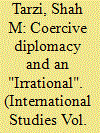

|
|
|
|
|
| Publication |
Jan-Mar 2005.
|
|
|
|
|
|
|
|
|
|
|
|
|
|
|
|
| 8 |
ID:
187358
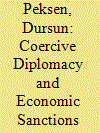

|
|
|
|
|
| Summary/Abstract |
Though reciprocity is an important aspect of coercive diplomacy, little is known about whether and when sanctioned countries (i.e., targets) respond to foreign pressure with their own counter-sanctions. The purpose of this article is to offer a comprehensive analysis of the conditions under which targets are more likely to employ economic counter-measures against their senders. Analyzing data for sanctions reciprocity episodes in the Threats and Imposition of Economic Sanctions (TIES) dataset, we find that targets with wealthier economies, less democratic regimes, or higher trade dependence on their senders are more likely to initiate reciprocal sanctions. Our findings also denote that sanctions reciprocity is more likely when targets are subject to sanctions by senders with poor economies or when the issue that instigates the initial sanctions is less salient. As the first cross-national, quantitative analysis of sanctions reciprocity, our analysis provides a more complete picture of how strategic ties between senders and targets unfold, and why some sanctions are more likely to fail or result in stalemate due to counter-sanctions employed by targets.
|
|
|
|
|
|
|
|
|
|
|
|
|
|
|
|
| 9 |
ID:
122602
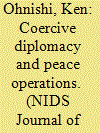

|
|
|
|
|
| Publication |
2012.
|
| Summary/Abstract |
This paper analyzes the activities of the International Force for East Timor (INTERFET) from the
perspectives of compellence and coercive diplomacy with the recognition that the proactive use of
force is also effective in peace operations and the appropriate concept underpinning such actions is
coercion, particularly compellence and coercive diplomacy. After a referendum on independence
from Indonesia in August 1999, East Timor was thrown into confusion by large-scale destruction
and forced displacement of residents by anti-independence militias. INTERFET that intervened to
restore security to East Timor used its military force to proactively put pressure on militias and
part of Indonesian troops to induce them to alter their actions. These behaviors of INTERFET can
be captured in line with the structure of coercive diplomacy and INTERFET's high-level military
capability and the existence of its clear objectives can be cited as factors contributing to its success.
As suggestions for peace operations in general, it can be pointed out that coercion by denial, rather
than by punishment, seems to be more effective in the context of peace operations and that it is
necessary to practice threats of denial across all areas of operations.
|
|
|
|
|
|
|
|
|
|
|
|
|
|
|
|
| 10 |
ID:
164289
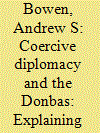

|
|
|
|
|
| Summary/Abstract |
What were Russia’s objectives in Eastern Ukraine, and why was it seemingly unable to achieve a successful or decisive outcome? In contrast to Russia’s seizure of Crimea, the uprising in Eastern Ukraine was marked by disorganization and chaos. Using proxy and surrogate actors, along with military exercises and the injection of Russian troops, Russia sought to institutionalize a political entity inside Ukraine to influence its domestic politics. In this article, I analyze the mechanisms by which Russia attempted to implement, and later salvage, its strategy. The article contributes to clearer theoretical and practical understanding of limited force in coercive diplomacy, signaling, and a more rigorous treatment of the role and uses of proxy actors.
|
|
|
|
|
|
|
|
|
|
|
|
|
|
|
|
| 11 |
ID:
078987


|
|
|
|
|
| Publication |
2007.
|
| Summary/Abstract |
The European Union has been the main international actor trying to contain the Iranian nuclear programme. In 2003, for the first time ever, the EU-3 adopted a coercive diplomatic approach vis-à-vis Iran. The current article begins with an analysis of the concept of coercive diplomacy before applying it to the Iranian case. In so doing, the article aims to make an interim assessment of the European (EU-3) effort.
|
|
|
|
|
|
|
|
|
|
|
|
|
|
|
|
| 12 |
ID:
114134
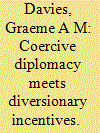

|
|
|
|
|
| Publication |
2012.
|
| Summary/Abstract |
This paper applies theories of strategic conflict avoidance and diversionary war to help explain US-Iranian interactions. The article argues that US attempts at coercive diplomacy have tended to strengthen hardliners in Iran by allowing them to frame opposition to government policies as support for the United States. In particular, US public uncertainty about the advisability of using force against Iran provided both the Supreme Leader and the Iranian President with an opportunity to increase tensions with the United States with little concern about provoking a military strike. The aggressive stance of the Iranian regime is about developing a threat which diverts attention from domestic problems and places it firmly in the arena of the international.
|
|
|
|
|
|
|
|
|
|
|
|
|
|
|
|
| 13 |
ID:
183164
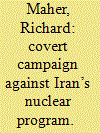

|
|
|
|
|
| Summary/Abstract |
This paper examines the covert campaign against Iran’s nuclear program and the implications it holds for both the theory and the practice of counterproliferation. The paper evaluates the degree to which covert action succeeded in producing meaningful delays and disruptions to Iran’s nuclear progress, in enhancing U.S. diplomatic leverage, and in helping to compel Iranian leaders to accept limits and restrictions on their country’s nuclear activities. More broadly, the paper analyzes the merits and viability of covert counterproliferation strategies, including how to define and measure the effectiveness of covert counterproliferation activity and how and under what conditions covert counterproliferation can be effective.
|
|
|
|
|
|
|
|
|
|
|
|
|
|
|
|
| 14 |
ID:
132526
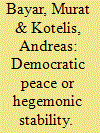

|
|
|
|
|
| Publication |
2014.
|
| Summary/Abstract |
Democratic peace theory (DPT) and hegemonic stability theory provide different explanations for cooperation among (democratic) states. The Imia/Kardak crisis took place between Greece and Turkey, two democratic, nonnuclear, and interdependent states in the post-Cold War era, thus, offers rare insights into these theorized processes. During this crisis, democratic actors and issues contributed to escalation, whereas war was prevented in the last minute by the coercive diplomacy of the USA. Based on our archival research in Greece and Turkey, our findings pose a challenge to the validity of the DPT for democratic dyads with territorial conflicts.
|
|
|
|
|
|
|
|
|
|
|
|
|
|
|
|
| 15 |
ID:
172698
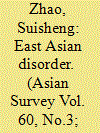

|
|
|
|
|
| Summary/Abstract |
In the South China Sea territorial disputes, China has shifted from a delaying strategy characterized by strategic ambiguity to strategic clarity and an increasingly assertive stance. Yet, this power play, asserting sovereignty over a large portion of the South China Sea, has not prompted a decisive push-back from regional states or major powers, raising the question of what kind of norms China will bring to the regional order and indicating the difficulty of building rules-based order in a region characterized by unbounded power politics in a twenty-first-century Hobbesian struggle.
|
|
|
|
|
|
|
|
|
|
|
|
|
|
|
|
| 16 |
ID:
140078
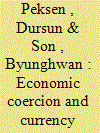

|
|
|
|
|
| Summary/Abstract |
Despite significant research on the efficacy and inadvertent humanitarian and political effects of economic sanctions, surprisingly little is known about the possible economic and financial consequences of sanctions for target economies. Synthesizing insights from the currency crisis literature with sanctions scholarship, we argue that economic sanctions are likely to trigger currency collapses, a major form of financial crisis that impedes economic growth and prosperity. We assert that economic coercion instigates currency crises by weakening the economy and creating political risks conducive to speculative attacks by currency traders. To substantiate the theoretical claims, we use time-series cross-national data for the 1970–2005 period. The results from the data analysis lend support for the hypothesis that sanctions undermine the financial stability of target countries. The findings also indicate that the adverse effect of economic coercion on the financial stability of target economies is likely to be conditioned by the severity of the coercion and the type of actors involved in the implementation of sanctions. The findings of this article add to the sanctions literature demonstrating how economic coercion could be detrimental to the target economy beyond the immediate effect on trade and investment. It also complements and adds to the literature on political economy of currency crises that has so far overlooked the significant role that economic coercion plays in financial crises.
|
|
|
|
|
|
|
|
|
|
|
|
|
|
|
|
| 17 |
ID:
144786
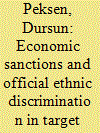

|
|
|
|
|
| Summary/Abstract |
Conventional studies on the consequences of sanctions tend to focus on the target society as a whole without specifying how foreign economic pressures might affect the well-being of vulnerable groups within target countries – the same groups who often disproportionately bear the burden of sanctions. This study explores the extent to which sanctions increase the likelihood of discriminatory government practices against one of the globally most vulnerable groups, ethnic groups. It is argued that sanctions contribute to the rise of official ethnic-based economic and political discrimination through contracting the economy and creating incentives for the target government to employ ethnic-based discriminatory policies. Using data on over 900 ethnic groups from 1950 to 2003, the results lend support for the theoretical claim that sanctions prompt the government to pursue ethnic-based discriminatory economic and political practices in multiethnic countries. The findings also indicate that multilateral sanctions are likely to be more harmful to the well-being of ethnic groups than sanctions levied by individual countries. Further, the negative effect of comprehensive sanctions appears to be greater than that of sanctions with moderate and limited impact on the target economy. The regime type of the target state, on the other hand, appears to have a significant role only in conditioning the hypothesized effect of sanctions on economic discrimination. Overall, this study’s focus on a vulnerable segment of the target society – ethnic groups – offers a greater understanding of the consequences of sanctions. It also provides additional insight as to how, in multiethnic countries, political elites might domestically respond to external pressures to retain power.
|
|
|
|
|
|
|
|
|
|
|
|
|
|
|
|
| 18 |
ID:
099875
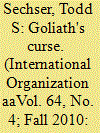

|
|
|
|
|
| Publication |
2010.
|
| Summary/Abstract |
States typically issue compellent threats against considerably weaker adversaries, yet their threats often fail. Why? Expanding on a standard model of international crisis bargaining, I argue that a theory of reputation-building can help shed light on this puzzle. The model casts reputation as a strategic problem, showing that challengers issuing compellent threats have incentives to anticipate the reputation costs that target states incur when appeasing aggressors. If challengers can recognize these costs and offset them with side payments or smaller demands, then even reputation-conscious targets will acquiesce. I argue, however, that military strength contributes to information problems that make challengers more likely to underestimate their targets' reputation costs and insufficiently compensate them. In this way, military power can undermine the effectiveness of compellent threats. The logic is illustrated by the 1939 Russo-Finnish crisis, and the argument's implications for the study of coercive diplomacy are explored.
|
|
|
|
|
|
|
|
|
|
|
|
|
|
|
|
| 19 |
ID:
148106
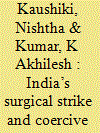

|
|
|
|
|
| Summary/Abstract |
India had been virtually driven to the wall in the wake of yet another terrorist attack on Indian army base in Uri. It has revived the memories of the Kaluchak and Pathankot attacks, and, 26/11. As India was caught unaware, it was probably believed by the government in power that an absolute majority in the Parliament and, after a stern warning after the Pathankot attack, Pakistan would probably not attempt any other mischief. While addressing a rally in Kerala, Prime Minister Narendra Modi stated that India will neither forget nor forgive the enormity of the Uri attack. This was also further followed by External Affairs Minister Sushma Swaraj’s evocative speech at the United Nations General Assembly (UNGA). However, the surgical strikes were unexpected given the policy of strategic restraint that India had followed in the past and indeed it was a resolute decision.
|
|
|
|
|
|
|
|
|
|
|
|
|
|
|
|
| 20 |
ID:
132931
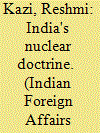

|
|
|
|
|
| Publication |
2014.
|
| Summary/Abstract |
The aim of India's nuclear deterrence capability has been to safeguard itself against blackmail and coercive diplomacy of adversaries. Its doctrinal principles of minimum nuclear deterrence and NFU are consistent with India's declaration of a modest nuclear weapons policy. The official announcements, in the aftermath of the May 1998 tests indicated that India has set out on a pragmatic course of action. Sixteen years after the tests, the Indian government's policies reflect this approach substantially.
|
|
|
|
|
|
|
|
|
|
|
|
|
|
|
|
|
|
|
|
|